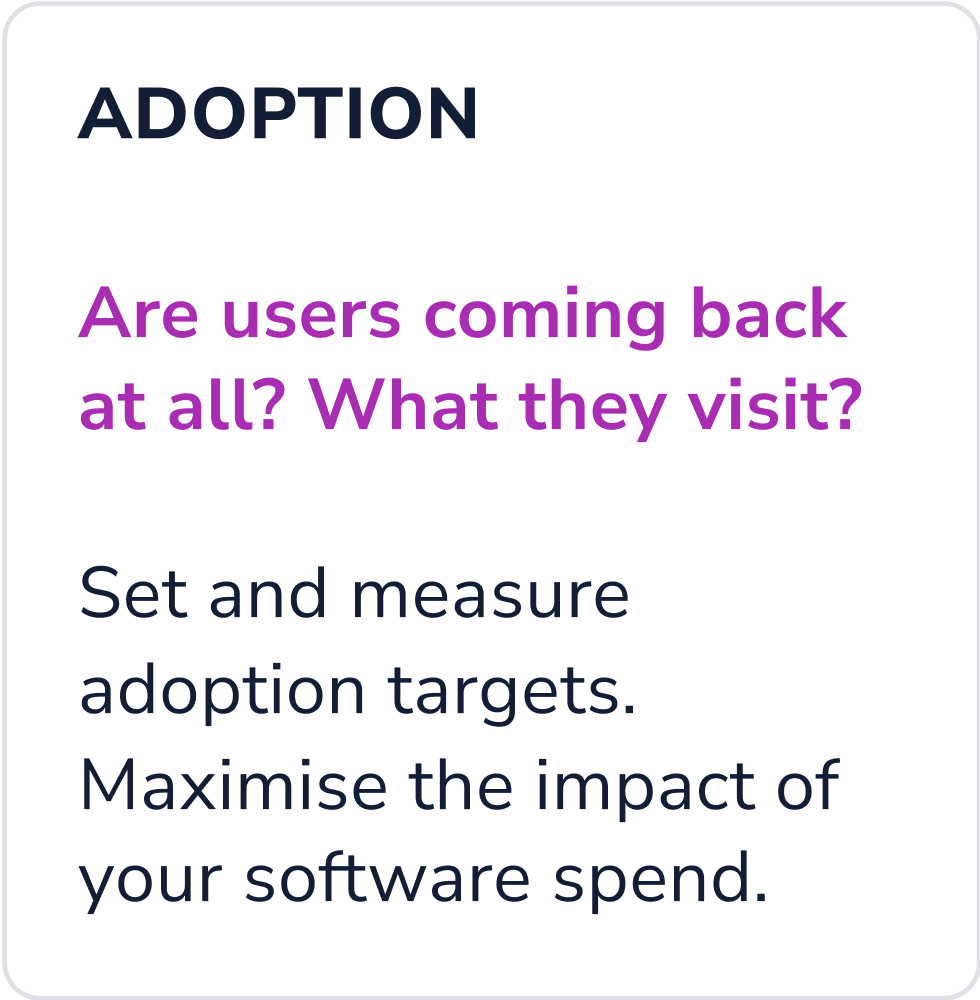HEART
Underlying app analytics
We created the world’s first standardized model to measure Digital Adoption of software applications. Inspired by Google’s framework for measuring UX, it answers our customers’ question: “How can we measure adoption of our digital tools?”
The journey from the question to solution
I’m a massive fan of a loosely followed design thinking process that goes through the stages you see below. Even though it’s supposed to be a non-linear process, I use it as a framework that serves as a guideline when working with my toolbox (approaches and methods I use in UX). So if you look at the chart below, you’ll see I’ve populated it with what we’ve done at a particular stage rather than what we were supposed to do. I’ve either led or been an instrumental part of the entries that are made BOLD.

Behind the scenes
Oh, the magic of the ideation stage… There is nothing better than to come together and just let our minds go wild exploring potential solutions, playing around in Miro or a whiteboard, participating in fun workshops, and finally, come together as a team, knowing that we’ve found the solution we are all happy (or at least okay) with.
At this stage, I continuously employ all my knowledge of being a strong facilitator and an elementary school teacher. I focus on bringing people together, getting early buy-in, and tons of feedback. If you’re curious about how I create workshops, click here to read my “short” reflection that I’ve published on the UXD Girl blog.


The concept is born
Knowing what to measure and track in your DAP analytics can be daunting. But there are key metrics and industry best practices to follow. We’ve done all the hard work to make sure our customers never miss an important insight.
My idea was to create a Design sprint to not only define the concept but also dive into the design and testing, but in the end, the timing was against us. Crucial stakeholders we’d need to include in the process were unavailable. Ultimately, I decided to lead a workshop that proved to be just as useful as we successfully defined the concept, which is the basis of the whole product.

Design
I’ve never enjoyed working as a designer on a project more than I did here.
The whole process was highly collaborative, and even though my Visual designer and I had minimal knowledge of designing dashboards, we confidently bit into the challenge. Knowledge from previously leading the redesign of the analytics helped me set the direction and know where to gain more dashboard knowledge.
Still, true design excellence happened on the project itself. We pushed the boundaries of problem-solving, brand design, and auto layout.
We were fortunate to work with the most dedicated team that supported our design efforts every step of the way, be it with direction, feedback, or a pep talk. Countless co-design sessions, feedback, and iterations, and we are proud of the solution presented below.








Next steps
Even though we’ve accomplished so much in the last year, we can only take a breath, high-five each other, and new challenges arrive. We are ready to tackle them!
NOW
- UX Awards application – Spring 2023 (Nov 2022) – Product category
- Early access testing performing continuous interviews with selected group of customers

NEXT
- Tags feature extended with goals or flows
- Task success page made more detailed with the addition of over time dynamic graph
LATER
- Task success page with an additional possibility to pin important tags and follow their progress
NEXT
- NPS Improvements focused on higher feature adoption rate
- Navigation redesign
- Analytics
- Portal
LATER
- Goals added to other HEART Subpages
- Expanded Happiness Subpage with addition of feedback related to Userlane
In an ideal world...
HEART is a strategic bet which means that the initiative didn’t primarily come from user pains and needs. That means that the design process was far from ideal.
Even though we are proud of the progress and the first feedback is extremely positive, the whole process was just as extremely stressful due to self-imposed deadlines, endless feedback loops, and an unclear understanding of the user.
It’s easy looking back and thinking, what if… and yet, we must learn from the past. That’s the spirit of Agile, growth, and good teamwork.
So, if I lived in an ideal world, I would bring to this project a clearer user voice, a stronger agile approach, and more autonomy for the team. There were times when this project felt more like an execution of one man’s vision (no matter how good the vision) than a user-oriented solution creation, and that left a mark on the team.
Behind every successful Project is an amazing team

- Me, Design lead – UX focus
- Gui Marques, Visual designer & Illustrator
- Marija Hajnal, Product manager
- Salvador Salzar, Tech lead
- Data experts
- FE & BE developers
- Quality assurance
- Marketing team – video creation
My role in the project
DESIGN LEAD - UX FOCUS
My role in the project was ensuring that we built the RIGHT SOLUTION in the FASTEST TIME possible.
I did this by helping the team focus on what’s important. I’ve facilitated critical collaborative sessions, created concepts, continuously provided feedback and guidelines, and supported PM and Tech lead in getting buy-in from stakeholders.







